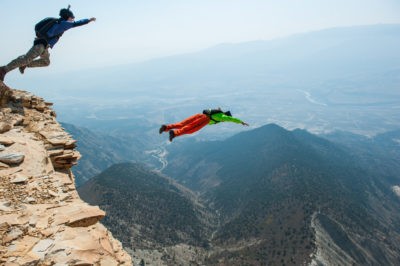The internet showcases extraordinary feats, including videos of daring athletes leaping from towering structures. In the skydiving world, these breathtaking stunts are known as BASE jumps. But What Is Base Jumping exactly? It’s more than just a thrill; it’s a discipline demanding expertise, precision, and a deep understanding of risk.
Defining BASE Jumping
The acronym “BASE” stands for Building, Antennae, Span (like bridges), and Earth (typically cliffs). These represent the four primary categories of fixed objects from which BASE jumpers launch themselves. Each jump is a calculated risk, pushing the boundaries of human capability.
Skydiving vs. BASE Jumping: Key Differences
While both skydiving and BASE jumping involve parachuting, significant differences exist. Aspiring BASE jumpers often begin with skydiving to gain crucial aerial experience. Most reputable BASE jumping courses require participants to have a solid skydiving background, typically between 200 and 500 jumps. The emphasis, however, is on skill mastery rather than just jump numbers.
This prior experience in skydiving equips BASE jumpers with a necessary understanding of parachute aerodynamics, essential for safe landings in confined spaces. BASE jumps often require landing in tight areas, such as a narrow street after jumping from a building.
Single vs. Dual Parachute Systems
A crucial distinction lies in the parachute systems used. BASE jumping employs a single-parachute system contained within a simple backpack. These systems lack regulation from organizations or governmental bodies.
Skydiving, conversely, uses a complex dual-parachute system. The Federal Aviation Administration mandates a main and a reserve parachute. Furthermore, skydiving systems often include an Automatic Activation Device (AAD), a sophisticated computer that automatically deploys the reserve parachute if specific altitude and speed parameters are met.
Exit Altitude Considerations
Another critical difference is the exit altitude. Skydiving jumps typically occur between 9,000 and 14,000 feet, with high-altitude options reaching 18,000 feet. Lower altitude skydives, known as hop-n-pops, range from 3,500 to 5,000 feet. In stark contrast, BASE jumps are frequently performed from altitudes of 486 feet or less.
Minimal Margin for Error
While skydiving has inherent risks, BASE jumping is significantly more dangerous. The low altitudes involved provide jumpers with only seconds to stabilize their bodies and deploy their parachute.
Moreover, BASE jumps often involve landing in challenging environments: rocky terrain, areas near power lines, or locations close to traffic. These factors amplify the inherent dangers of BASE jumping considerably.
Steps to Starting BASE Jumping
Interested individuals should first gain experience in skydiving. Aspiring BASE jumpers often find mentors within the skydiving community. Prioritize developing a stable body position during skydiving and honing canopy flight skills. When you feel ready and have mastered these skills, seek guidance from experienced skydivers who can direct you to a reputable BASE jumping course.
